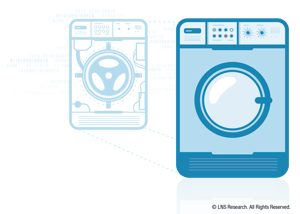On Tuesday, October 16, LNS Research hosted the webcast, “Digital Twin: Discrete Manufacturers Making the Connection from Innovation to Performance.” The presentation explained the state of play of Digital Twin in discrete industries, where it’s going in the coming years, and how this exciting mix of real with virtual for products and assets will deliver endless possibilities to improve performance and competitive advantage in discrete manufacturing.
Click here to speak with Andrew Hughes.
 Q1: You mentioned complex architectures to support Digital Twins. Is that investment a prerequisite to developing Digital Twins?
Q1: You mentioned complex architectures to support Digital Twins. Is that investment a prerequisite to developing Digital Twins?
A1: No, not to start with Digital Twin – especially if you already have a product life-cycle management (PLM) platform and enough applications running on it to support first-generation twins. In the long-term companies undertaking Industrial Transformation programs should consider the support for PLM, simulation and Digital Twins of product and process as a prerequisite for value generation; I will qualify that with “in the right industries.”
Q2: How do you see the convergence of engineering and operations in support of the Digital Twin initiative?
A2: Engineering and operations (OT) convergence is likely to cause less human friction than the IT-OT convergence. Design engineers are sometimes involved in engineering the production line and the product; a third kind, the process engineer, will certainly help to bridge that gap. There will often be some friction about master data and who really owns the output of various stages of product and production design. Engineering and manufacturing bills of material (eBOM, mBOM) are closely related but used for different purposes – indeed, IT will re-enter the fray as they are a primary user, and often master, of the mBOM.
So, you can see that there are a lot of interactions between various departments and technologies but there is one important factor – it will take a lot of goodwill to make it work.
Q3: How do companies go about estimating the ROI for a Digital Twin?
A3: As per our Digital Twin survey, for initial Digital Twin projects 50% of companies stated achieving ROI anywhere from three months to two years. 23% achieved once in two years and 27% ranged between three to six months. It’s not a quick or immediate return on investment but it is assured, and the opportunity to get returns is excellent.
Q4: How is the Digital Twin evolving and are expectations about Digital Twin in manufacturing changing?
A4: The Digital Twin continues to grow and evolve. Depending on an enterprise’s business need, there are many views of the Digital Twin. We often see companies using Digital Twin to:
- Create a twin that can be used for engineering, design, production, and supply chain optimization including field services
- Increase integration and digital continuity to connect departments and functions
- Improve shop floor agility and equipment life-cycle (planning, operation, maintenance)
- Improve productivity across design, production processes and quality inspection processes enable closed-loop quality and manufacturing innovation
Q5: How is Digital Twin being used in field services?
A5: The manufacturer can supply new technology-based services to their aligned service representatives including, as an example, Virtual Reality to guide service engineers working on their products. These are potentially new revenue streams, and gives the customer the benefit of faster, cheaper and better maintenance.
Q6: Is there any benefit for supply chain management with a Digital Twin?
A6: A Digital Twin can enable smart manufacturing by integrating engineering and supply chain to compress lead times and decrease ramp-up times based on projected demand. Digital Twin can also help respond rapidly and validate requirements of production with supply and optimize processes before production goes live to ensure smoother operations. In fact, Digital Twins can make the operations lean even before beginning full production.